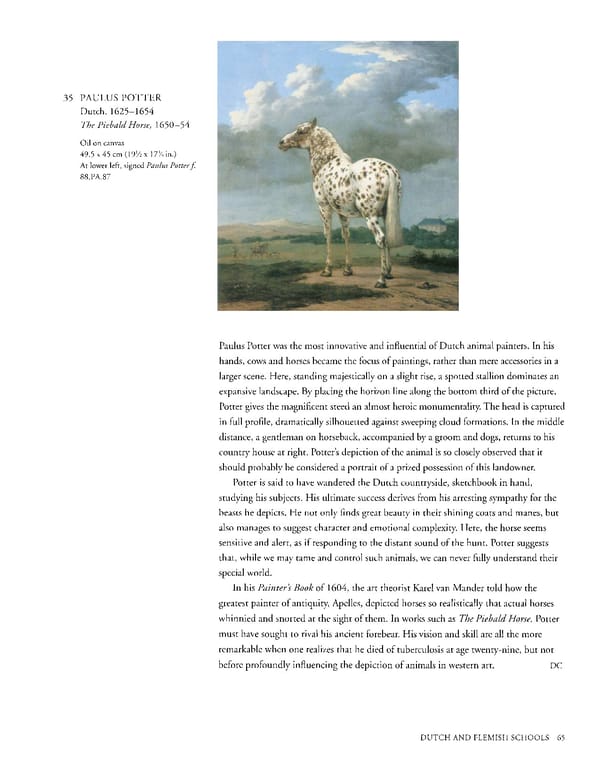35 PAULUS POTTER Dutch, 1625-1654 The Piebald Horse, 1650-54 Oil on canvas 49.5 x 45 cm (19½ x 17¾ in.) At lower left, signed Paulus Potter f. 88.PA.87 Paulus Potter was the most innovative and influential of Dutch animal painters. In his hands, cows and horses became the focus of paintings, rather than mere accessories in a larger scene. Here, standing majestically on a slight rise, a spotted stallion dominates an expansive landscape. By placing the horizon line along the bottom third of the picture, Potter gives the magnificent steed an almost heroic monumentality. The head is captured in full profile, dramatically silhouetted against sweeping cloud formations. In the middle distance, a gentleman on horseback, accompanied by a groom and dogs, returns to his country house at right. Potter's depiction of the animal is so closely observed that it should probably be considered a portrait of a prized possession of this landowner. Potter is said to have wandered the Dutch countryside, sketchbook in hand, studying his subjects. His ultimate success derives from his arresting sympathy for the beasts he depicts. He not only finds great beauty in their shining coats and manes, but also manages to suggest character and emotional complexity. Here, the horse seems sensitive and alert, as if responding to the distant sound of the hunt. Potter suggests that, while we may tame and control such animals, we can never fully understand their special world. In his Painter's Book of 1604, the art theorist Karel van Mander told how the greatest painter of antiquity, Apelles, depicted horses so realistically that actual horses whinnied and snorted at the sight of them. In works such as The Piebald Horse, Potter must have sought to rival his ancient forebear. His vision and skill are all the more remarkable when one realizes that he died of tuberculosis at age twenty-nine, but not before profoundly influencing the depiction of animals in western art. DC DUTCH AND FLEMISH SCHOOLS 65
 Masterpieces of the Getty Museum: Paintings Page 65 Page 67
Masterpieces of the Getty Museum: Paintings Page 65 Page 67